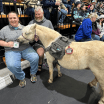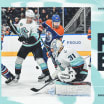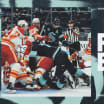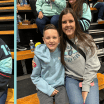For Villalobos, the form started as a young girl when her mother sat her down with tempera paints and butcher block paper instead a television or another electronic device to occupy the mind and body while mom worked. During those painting sessions, young Angelina let both her imagination and brush strokes swirl.
These days, Villalobos' flowing style is evident in the mural tradition of pieces painted on walls and ceilings and fences and houses and other permanent structures. But she doesn't stop at the conventional or historical: She has been commissioned to paint murals on utility boxes, restaurant entries, food trucks, pipes, windows, hostel common rooms and, recently, the first "A" in the Black Lives Matter on-the-actual-street mural in the Capitol Hill neighborhood.
"Art can go anywhere and just like humans it can belong anywhere," says Villalobos during a video interview for the "Kraken Fighting Spirit Presented by Modelo" series. "When I start a project, I ask myself two questions: Where is it going? And who is it serving? It's important to me that I think about how people will appreciate the art."
For each mural, Villalobos wants to create a mural that "belongs" in that particular place and societal space. The concept of belonging is mission critical to Villalobos, who goes by "179" as an artist (check out our embedded video with this story to find out why). When she mentors teenage students at local schools-lately on Zoom and "much harder"-Villalobos hears a common theme. Teens of color "regularly say they don't feel like they belong."
"One thing I like to put out there is [Seattle] is growing at an exponential speed, which can be good and bad," says Villalobos. "We can't assume everyone is coming along with us or that they will catch up. No, we have to wait or implement programming that will allow people and especially youth to have the space to grow at their own pace."
A parent of a teen herself, Villalobos offers observations and experience about communication with teens rather than framing it as advice: "A lot of youth feel like they are not listened to. Instead of talking at them, I look to ask questions and thoroughly listen to their answers. Not just listen but comprehend. Then I ask them more questions [about what the teen expressed]. I look to give them a platform."
Villalobos says the Kraken and other organizations on the Seattle Center campus can be a leader in creating a clear sense of belonging with Latinx youth and other kids of color. She's enthused when proposed with the concept of leading art-as-expression talks for youth at the Kraken training and community center under construction at Northgate. She fondly remembers going on school field trips to the Seattle Opera and Seattle Art Museum-places where "I might not feel traditionally that I belong"-inspiring her to feel part of things. She credits the Seattle Children's Theatre with providing a foundation for the storytelling she does with her art.
"When I think of hockey [coming to Climate Pledge Arena], I usually think of a certain demographic and that I don't know the sport myself but want to learn more," says Villalobos. "One reason I am excited about a hockey team is hockey is played in many countries in Europe. I think hockey can globally connect with other countries.
Villalobos is most definitely part of belong with the Climate Pledge Arena. She painted a mural on the site's outer construction wall not far from the International Fountain on the Seattle Center campus. Her take on what she produced on that wall: "It flows left to right and flows and swoops into a giant wave."
When Villalobos works on larger murals, she employs all sorts of physical and mental strengths in her repertoire. She is on ladders a lot ("I am a shorter person" she says, smiling). Pensive one minute, the next twisting and creating and spraying paint around pipes, exhaust vents, windows, you name it. She sees the parallels to the nature she makes a point of visiting in the Pacific Northwest.
"I love Seattle so much," she says. "You can go two hours in any direction and see a different climate ... and all of the different landscapes. You see nature can grow over and through things. I think it represents our determination as humans to adapt and grow."


















